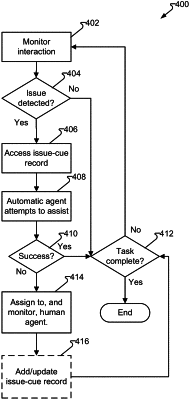| CPC G06Q 30/0613 (2013.01) [G06Q 30/0623 (2013.01); H04L 51/04 (2013.01)] | 20 Claims |

|
1. A system, comprising:
a network interface;
a data storage; and
a processor configured to conduct an automated co-browsing interaction with a customer device over a network via the network interface, wherein, the customer device is operated by a customer, and wherein the processor is configured to:
receive a first set of signals, via the network interface, from the customer device, the first set of signals being associated with a task on the customer device, wherein the task comprises a task element to be completed via the customer device;
determining, whether the first set of signals indicates a failure to complete the task upon determining that progress to complete the task element has stalled; and
in response to determining that the first set of signals indicate the failure to complete the task:
access, from the data storage, a co-browsing behavior in accordance with the task;
transmit a second set of signals, via the network interface, to cause the customer device to present the co-browsing behavior associated with completing the task;
monitor the automated co-browsing interaction, following transmission of the second set of signals, and determine therefrom, whether the second set of signals failed to complete the task; and
upon determining that the second set of signals failed to complete the task, connect the automated co-browsing interaction to an agent terminal operated by a human agent and cause the automated co-browsing interaction to include a third set of signals from the agent terminal.
|